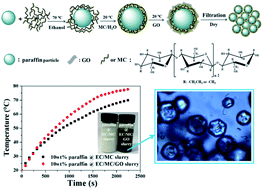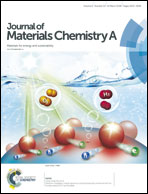Novel facile self-assembly approach to construct graphene oxide-decorated phase-change microcapsules with enhanced photo-to-thermal conversion performance†
Abstract
In this study, self-assembled and graphene oxide (GO) modified microcapsules of paraffin@mixed cellulose were prepared. The microstructure and morphology of the as-prepared phase-change composites were characterized by a polarizing microscope, SEM, FT-IR, XRD, and Raman spectrum. The results indicated that the paraffin@ethylcellulose (EC)/methylcellulose (MC)/GO composite consists of spherical particles that have core@shell structure, which indicates the absence of chemical reactions between the core (i.e., paraffin) and shell (i.e., EC/MC/GO) materials. The melting temperature (i.e., 49.7 °C) and latent heat (i.e., 152.2 J g−1) of the paraffin@EC/MC/GO composite were determined through DSC. The encapsulation rate of paraffin in the composite can be as high as 85.4% based on the results of the DSC measurement. The as-prepared paraffin@EC/MC/GO composites had no leakage, which was observed by SEM, and possess perfect phase-change capability after experiencing 100 melting–freezing cycles. Furthermore, the microencapsulation was dispersed into the base fluid (i.e., water) to form a stable suspension, which shows enhanced photo-thermal conversion performance with temperature range from 30 to 80 °C. The efficiency of paraffin@EC/MC/GO-based phase-change slurry is maintained at 80% in a wide temperature range compared with that of paraffin@EC/MC-based phase-change slurry. The paraffin@EC/MC/GO composite with high thermal storage capacity, good thermal reliability and enhanced photothermal performance exhibits a good potential for using as a solar thermal storage material in practical applications.



 Please wait while we load your content...
Please wait while we load your content...